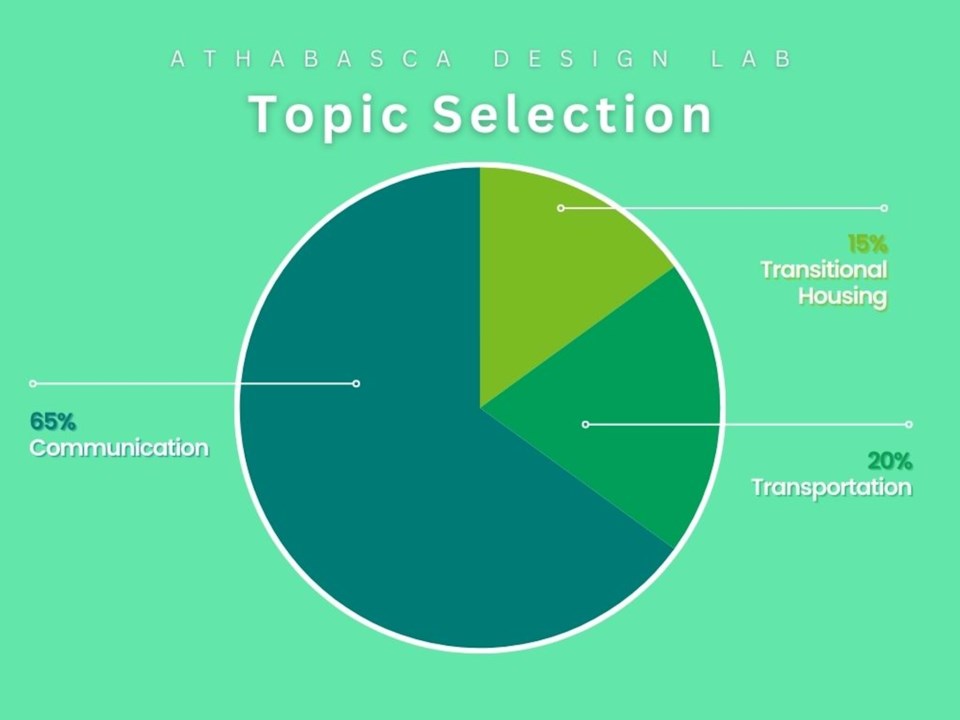ATHABASCA — Eight months after The Social Impact Lab Alberta (SIL AB) landed in Athabasca, residents of the town and county were able to test out and provide their feedback on four different prototypes a group of dedicated locals hope will create better communication in the area.
More than 30 individuals who consider the Athabasca region home braved the rainy weather on May 16 to make an appearance at Athabasca University (AU) for the first look at the yields of the Design Lab, a process employing community-led design to solve a local issue.
“It’s nice to see something offered like this in our community, even opportunities to come connect with other members of the community,” said Jordan Stockwell, a tester living in Athabasca County.
Stockwell was among the other Athabascan testers, who engaged in demonstrations for four different prototypes for eliminating communication gaps while fostering feelings of belonging.
The group of 30-some designers involved in the process identified communication as the most pervasive and impactful topic to tackle after initially exploring other social issues such as housing, transportation and mental health.
With a focus on grassroots, community-driven solutions for social issues, the lab is funded by United Way of Calgary and Area and facilitated by United Way project designers. A grant of $10,000 will be put towards the most feasible, viable, and desirable solution at the end of the nine-month process.
“Athabasca’s a great community, it’s nice that there is a group of people trying to make it even better,” said Monique Davis, another county resident. “I hope that this ends up working, and it just makes our community even more tight-knit.”
Project Prototypes
Davis, Stockwell, and the other testers perused AU’s academic research centre to engage with the four prototypes on display. In previous sessions, designers were asked to find unique solutions to communication issues employed elsewhere in the world, and narrowed those solutions down to the four they thought would be most applicable to Athabasca.
One proposed solution was a digital information kiosk not unlike the navigation devices seen in shopping malls. The kiosk would house information on where to eat, recreation opportunities in the area, where to find other resources, and anything else visitors and locals would like to know.
If selected, the kiosks would be installed in high-use areas around the town, potentially even the wider county, and would come with multiple language options for those who don’t speak English.
“The information kiosk was something that I think would be used within the community,” said Davis. “If something like that is put in a place that’s frequented, like a grocery store or a gas station, I feel like people would more likely use something like that.
Another solution tested was a community connection campfire and event planning guide. The prototype featured a mock-up pamphlet, which, if created, would act as an instruction manual for planning small community events — like a neighbourhood campfire — intended to foster face-to-face connection.
The manual would act as a guide to determine a focus for events, which could centre around a common interest like birdwatching, and provide tips for creating a welcoming space.
“The community campfire, I think that’s a wonderful idea, but I think you see those things try happen sometimes and people don’t utilize them, so I would fear that would happen,” said Stockwell.
The third solution open for feedback was a community coordinator job, complete with a description of the roles and responsibilities of the position, and examples of common concerns a coordinator could clear up.
In an ideal world, the coordinator would be a full-time position, would exist in both a physical space and online avenues, and would act as a curator for all resources, events, and information in Athabasca.
Eric Geck, a tester who calls the town home, said he wasn’t able to pick a favourite out of the mix. “They’re all great ideas, I love every single one of them.”
Geck said in his opinion, the community coordinator could fill connectivity and communication gaps experienced by those without the time or the social battery to plan a community event, for instance.
Finally, the last prototype on display for testing was a community hub — the hub, or gallery, would be a physical location with a staff member that residents and visitors could utilize.
The hub would provide the same information and access to resources as the community coordinator prototype, complete with an event calendar for community planning, and displays of local art and goods.
“Our community’s kind of missing out on all this stuff, and if we could incorporate it into one, that would be totally ideal for everybody,” said Geck.
Another round of community testing is scheduled June 6, from 10 a.m. to 1 p.m. Any Athabascans eager to test prototypes, give their feedback, and enjoy a free lunch can register for testing by emailing [email protected].



